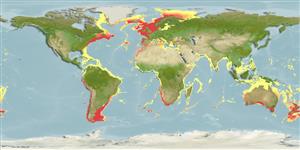Classification / Names
Common names from other countries
Issue
Squalus suckleyi (Girard, 1855) has been resurected by Ebert et al. (2010: Ref. 85328) in the North Pacific where it replaces Squalus acanthias Linnaeus, 1758.
Main reference
Size / Weight / Age
Max length : 160 cm TL male/unsexed; (Ref. 247); common length : 100.0 cm TL male/unsexed; (Ref. ); max. published weight: 9.1 kg (Ref. 11389); max. reported age: 75 years (Ref. 39247)
Length at first maturity
Lm 81.4, range 69 - 100 cm
Environment
Marine; brackish; benthopelagic; oceanodromous (Ref. 51243); depth range 0 - 1460 m (Ref. 26346), usually 50 - 300 m (Ref. 43939)
Climate / Range
Temperate; 7°C - 15°C (Ref. 247), preferred 16°C (Ref. 107945); 81°N - 57°S, 82°W - 171°W (Ref. 247)
Distribution
Western Atlantic: Greenland to Argentina; Eastern Atlantic: Iceland and and the Barents Sea to Western Sahara and the Canary Islands; Angola to South Africa. Indo-Pacific; the Mediterranean and Black Seas (Ref. 247) Reports from off New Guinea are doubtful (Ref. 6871). All records from North Pacific refer to Squalus suckleyi (Girard, 1855) (Ref. 85328). Appendix II (northern hemisphere populations) of the Bonn Convention (2009).
Countries | FAO areas | Ecosystems | Occurrences | Introductions
Short description
Dorsal
spines
(total): 2;
Dorsal
soft rays
(total): 0;
Anal
spines: 0;
Anal
soft rays: 0;
Vertebrae: 101 - 109. This moderately sized species is distinguished by the following set of characters: very slender body, abdomen width 7.2-9.2% TL; narrow head, width at mouth 7.9-10.2% TL; mouth width 1.7-2.2 times its horizontal prenarial length; moderately long snout, preoral length 2.2-2.5 times horizontal prenarial length, 8.5-9.8% TL; single-lobed anterior nasal flap; small dorsal fins, raked, first dorsal-fin height 1.1-1.3 times its inner margin length, second dorsal-fin height 0.7-0.9 times its inner margin length; origin of first dorsal-fin located just posterior to pectoral-fin free rear tips; exposed bases of dorsal-fin spines relatively narrow, 0.4-0.7% TL; short spine of first dorsal fin, exposed length 1.7-2.7% TL; pectoral-fin anterior margin 1.9-3.1 times its inner margin length; preventral caudal margin 1.9-2.6 times inner margin of pelvic fin; pale caudal fin with poorly demarcated, whitish margin, blackish caudal blotch at the apex of upper lobe, anterior margins of both lobes whitish in juveniles; dark caudal bar absent; dorsal and lateral surfaces of body bluish grey with an irregular array of moderately-large white spots; whitish ventrally; flank denticles tricuspid; monospondylous centra 41-45, precaudal centra 74-79, total centra 100-105 (Ref. 58446).
IUCN Red List Status (Ref. 115185)
Human uses
Fisheries: commercial; gamefish: yes
Tools
Special reports
Download XML
Internet sources
Estimates of some properties based on models
Phylogenetic diversity index
PD50 = 0.5000 many relatives (e.g. carps) 0.5 - 2.0 few relatives (e.g. lungfishes)
Trophic Level
4.4 ±0.4 se; Based on diet studies.
Resilience
Very Low, minimum population doubling time more than 14 years (rm=0.034; K=0.03-0.07; tm=10-30; tmax=75; Fec=1)
Vulnerability
High to very high vulnerability (68 of 100)
Price category
